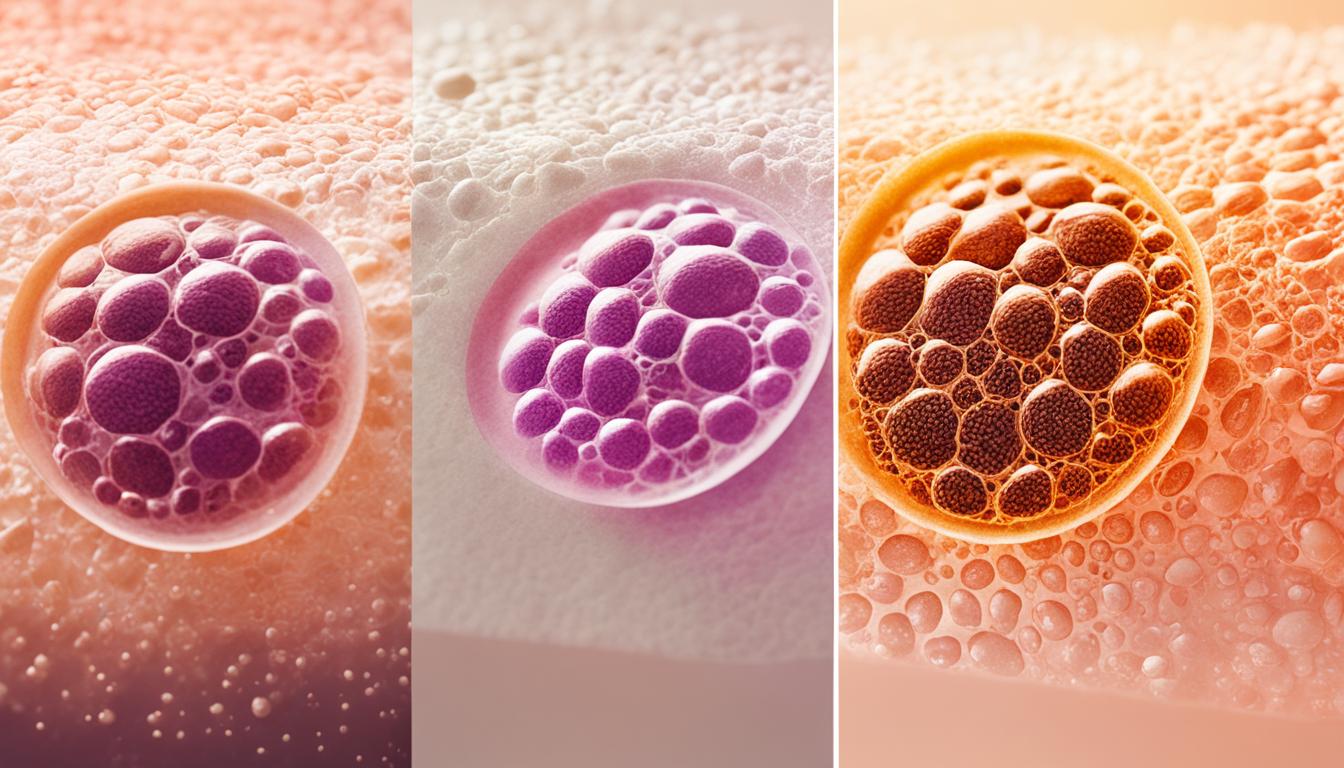Nonmelanoma skin cancer is a common cancer type, including SCC and BCC. It shows up as unusual cell growth on the skin’s top layer. Causes often include too much sun, light skin, weak immunity, chemical exposure, and family history.
This cancer needs early symptom spotting for quick treatment. Look for new growths, non-healing sores, red patches, or shiny bumps. If you notice these signs, see a doctor right away for a check-up.
Doctors usually diagnose this cancer by looking at your skin. Sometimes they need a biopsy. In a biopsy, they take a tiny skin piece to check for cancer cells under a microscope.
The treatment of nonmelanoma skin cancer depends on the cancer’s stage and type. Options range from surgery to cryotherapy, which is freezing the cancer cells away. Doctors pick the best treatment for each person.
Stem cell therapy is showing promise in treating this kind of cancer. Stem cells can turn into different cell types and help repair damaged tissues. They may also slow down cancer growth. More studies are ongoing to see how well this therapy works over time.
Key Takeaways:
- Nonmelanoma skin cancer includes squamous cell carcinoma (SCC) and basal cell carcinoma (BCC).
- Risk factors for nonmelanoma skin cancer include excessive sun exposure, fair skin, weakened immune system, exposure to certain chemicals, and family history.
- Common symptoms of nonmelanoma skin cancer include the appearance of new growth, non-healing sores, red scaly patches, or shiny bumps on the skin.
- Diagnosis is usually done through a visual examination of the skin and may require a biopsy for confirmation.
- Treatment options include surgery, radiation therapy, topical medications, cryotherapy, and emerging stem cell therapy.
Risk Factors and Prevention of Nonmelanoma Skin Cancer
To stop nonmelanoma skin cancer, we must know its risk factors. This knowledge lets us actively protect ourselves. It’s key to avoiding this type of cancer.
Risk Factors
Certain elements can up the chances of getting nonmelanoma skin cancer. These comprise:
- Too much sun or tanning bed UV exposure
- Pale skin that burns quickly
- Many past sunburns
- Weakened immune systems
- Direct contact with some chemicals, like arsenic
- Having family members with the disease
Though these factors boost the risk, they’re not guarantees. Someone with no known risks could still get skin cancer.
Prevention
Preventing nonmelanoma skin cancer is vital. By adopting sun-safe practices, one can lower the risk. Here are key steps to prevent it:
- Wear clothing that shields the skin, like long sleeves and hats
- Apply high SPF sunscreen often to unprotected skin
- Find shade when the sun is strongest, usually 10 a.m. to 4 p.m.
- Avoid tanning beds for their harmful UV light
- Regularly check your skin for new or changing spots
- Get screened by a skin doctor to catch issues early
By sticking to these steps, we can cut the risk of skin cancer. This boosts our skin’s health overall.
| Risk Factors | Prevention Strategies |
|---|---|
| Excessive exposure to UV radiation | Wear protective clothing Use sunscreen with a high SPF Seek shade during peak sun hours |
| Fair skin that sunburns easily | Wear protective clothing Use sunscreen with a high SPF Avoid tanning beds |
| History of frequent sunburns | Wear protective clothing Use sunscreen with a high SPF Seek shade during peak sun hours |
| Weakened immune system | Wear protective clothing Use sunscreen with a high SPF Avoid tanning beds |
| Exposure to certain chemicals | Wear protective clothing Use sunscreen with a high SPF Seek shade during peak sun hours |
| Family history of the disease | Wear protective clothing Use sunscreen with a high SPF Avoid tanning beds |
Symptoms and Diagnosis of Nonmelanoma Skin Cancer
Nonmelanoma skin cancer shows different symptoms based on type and stage. Knowing these signs is key to finding it early. The main signs include:
- Development of a new growth on the skin
- A sore that does not heal
- A red scaly patch
- A shiny bump
If you have itching, bleeding, or see moles change, it might be a sign. This is why spotting these early is critical.
Diagnosing it often starts with a skin check by a dermatologist. This lets them look for any odd or worrying spots. If they’re not sure, a biopsy might be done. In a biopsy, a piece of the affected skin is taken to see it under a microscope.
Early Detection and Regular Skin Examinations
Checking your skin often can help find nonmelanoma skin cancer early. Look for new growths or any changes in moles. If you see something, get it checked by a doctor right away. Also, seeing a dermatologist for screenings is crucial. They can spot skin cancer early on, which improves your chances of beating it.
Stem Cell Therapy for Nonmelanoma Skin Cancer
Stem cell therapy is a new way to treat nonmelanoma skin cancer. Stem cells are special because they can turn into different cells. This ability is key for repairing tissues and stopping cancer cells from growing. When used for skin cancer, stem cell therapy can help grow new skin cells. It also cuts down on inflammation and boosts the immune system. Studies show it helps wounds heal faster, lessens scars, and might even shrink tumors.
Despite these promising results, we need more research on how well stem cell therapy works for skin cancer. Advances in this area could greatly improve how we treat this type of cancer. The hope is to make things better for patients and offer new solutions for dealing with skin cancer.
In short, stem cell therapy is a groundbreaking way to fight skin cancer without melanoma. It uses stem cells’ natural ability to repair to heal the skin. As we learn more, this therapy could change how we manage this cancer, giving people better and more focused care.

